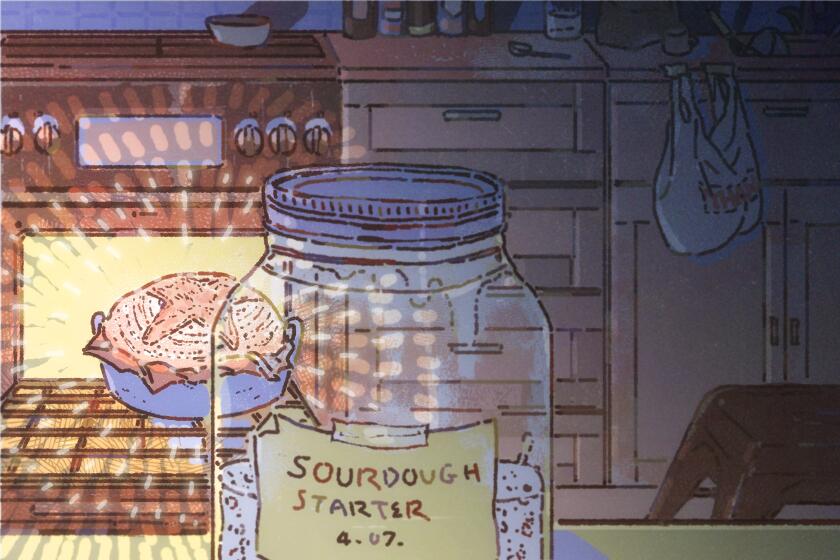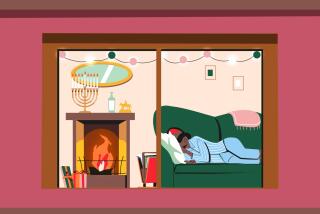We’re churning butter and making our own candles. What has coronavirus done to us?
For years, consumers have been seeking out anything that can save them time: coffee pods, meals in boxes, and voice-activated virtual assistants with the answer to any question — no matter how inane or mundane. Now, with many Americans confined to their homes amid the coronavirus crisis, some buyers are looking for the opposite.
At Lehman’s, a Kidron, Ohio, hardware and appliance store, butter churns have quickly gone from a slow seller to a hot commodity. Sales of the company’s large Dazey churn have increased 250% since the beginning of March, the company said, and the $199.99 model is now sold out. Purchases of two smaller churns are up threefold, too.
Galen Lehman, chief executive of the family business, attributes the increase to the COVID-19 pandemic, which he believes is causing people to seek out things that are “creative, satisfying, comforting and restorative when [they’re] worn out.”
“I think our soul craves a simpler life,” he said.
Many people in recent months have taken up wholesome around-the-house hobbies such as baking or gardening — the kind of unsurprising things you’d ordinarily do if you had a bit more time. But churning butter?
As Americans endure a second month of sheltering at home, some are going full-on “Little House on the Prairie,” pursuing anachronistic activities that they’d never otherwise consider. (Yes, a butter churn makes an appearance in “Little House in the Big Woods,” the first book in the series by Laura Ingalls Wilder.)
Staying home is difficult for many. For some, being at home is a welcome change of pace.
People are dabbling in diversions that were once necessities — 150 years ago — effectively tapping into a past they never experienced. It’s not just about churning butter: Merchants reported that sales of candle-making kits and washboards are up dramatically.
At Lone Star Candle Supply in Fort Worth, sales of candle-making starter kits have doubled since the outbreak began. “It took us by surprise, to be really honest,” said Blair Clark, the company’s office manager. “What the heck is happening?”
That’s a good question. Unlike the comparatively quick gratification of baking a loaf of sourdough, some of these pursuits are laborious endeavors, with less obvious or immediate payoffs. They are also ones that technology has allowed us to move on from — decades and decades ago.
But it’s not surprising to Sue Poremba, president of the Laura Ingalls Wilder Legacy and Research Assn. — and whom better to talk to than a “Little House” expert?
“It’s, in a sense, a survival technique,” Poremba said. “People right now are feeling like they want to get back to an old-time sense of independence.”
That frontier logic tracks with the thinking of experts on consumer behavior.
The pandemic is leading to uncertainty that’s challenging people’s images of themselves, and this could be leading some to seek reassurance through hard work, said Alexander Chernev, professor of marketing at Northwestern University.
“You might have lost your job or wonder if you will have one in a month,” he said. “This challenges your self-identity and you can look for different ways to affirm your identity, which can lead to activities that are not necessarily in search of the easiest thing. You are likely to seek things that are more authentic in some sense. In this case, they require more effort.”
All this time at home has a side effect: A chance to learn more about ourselves and the people we’re with. Here’s how to have your a-ha moment.
Other people, now facing an increased reliance on technology, such as virtual meetings and online shopping, could be looking for something that feels real, said Tom Meyvis, professor of marketing at New York University.
“Technology is ... a little bit alienating and doesn’t give you the full human experience,” he said. “It’s not what we’re hard-wired for — we are hard-wired for personal contact, tactile experiences. I think that’s what people are missing ... so we are trying to meet these needs in a subconscious way.”
Academics pointed to a few other hypotheses to explain the increased interest in antiquated items: families looking to entertain children cooped up inside, shoppers feeling nostalgic as they turn to retail therapy, or the understandable desire to journey back to a simpler time.
Jill Avery, a senior lecturer in the marketing unit at Harvard Business School, said nostalgia-driven purchases can serve as talismans for shoppers seeking a mental escape to “a slower, less stressful, less media-dominated, and less commercial existence than that offered by our contemporary lives.”
“Nostalgia is a strong motivator for purchase, particularly nostalgia not for our own past — which often contains both positive and negative associations — but for a period in the past that we ourselves have not directly experienced,” she said.
Merchants, though, had simpler explanations. Clark, the office manager at Lone Star Candle Supply, attributes increased sales to people who are “at home and are bored, basically.”
At times in recent weeks, the company has sold out of three different candle-making starter kits, each of which costs about $80. “We were not expecting it to be as crazy as it has been,” she said.
It’s not preppers or survivalists, Clark presumes, who are buying up the candle-making kits.
“If [customers] were concerned about having a light source, they could just buy wax jars and wicks,” Clark said, adding that making a candle isn’t exactly a quick process. “It would take an hour to make your first few.”
If that task doesn’t sound strenuous enough, consider a washboard. Columbus Washboard Co. would be happy to sell you one — that is, if it has any in stock.
According to Marissa Fickel, the Logan, Ohio-based company’s factory manager, sales have tripled since the start of the coronavirus outbreak. In normal times, she said, the company would have 20 or so orders to fill on a Monday after a weekend’s worth of sales. On a Monday in March, she and colleagues came into the office to find the company had received 120 orders.
I’m choosing to be hopeful in these dark days. And I’m starting with something simple: a sourdough starter.
A popular item, Fickel said, has been the $32.99 MaidRite washboard, which is family-size and includes a washing surface made of galvanized steel.
The strong demand is coming during a period of great economic uncertainty, and doing laundry this way is less expensive than using a machine. That reason, coupled with health concerns associated with coming into contact with others, could explain the rash of new customers.
“It is mostly people who aren’t able or don’t want to go to the laundromat, or people who live in apartment buildings who don’t want to use shared laundry facilities,” she said.
Before the pandemic, a much larger swath of the company’s business centered on selling the washboards for musical instruments. Now, though, customers are “using them because they need to use them,” Fickel said. “I think it is out of necessity.”
When jurisdictions began issuing stay-at-home orders, Poremba, the “Little House” expert, said she wasn’t surprised to find that people began pursuing old-fashioned pastimes. And the pandemic reminded her of something from the book series.
“[It] is about a family that survived within itself in isolation situations, and families right now are trying to figure out ways to connect to each other,” Poremba said. “I suspect a lot of people buying butter churns and washboards and such ... have moved from ‘Hey we made our own sourdough bread’ to ‘How about we make our butter to go with it?’”
The butter churn sold by Lehman’s is an updated version of an American classic: the Dazey, which was created in 1904. Lehman’s bought the Dazey brand in 2013 and introduced a new version with a revised paddle that more thoroughly churns the cream, speeding up the process.
Though sales have increased dramatically on a year-over-year basis, the butter churn business remains niche. Lehman’s has sold 43 of its large Dazey model since the beginning of March, whereas it typically sells fewer than 10 per month.
After all this talk of butter, this reporter was interested in, you know, actually making some. (And eating it.) Though the large model was sold out on Lehman’s website, the $29.99 Micro version — the smallest of three — still promised the “quality that you know.”
Taking it out of the package, the advice of an expert, farmer Karen Geiser, came to mind. She said to prepare for a workout.
In the midst of this coronavirus crisis, I just wanted a simple mask for running essential errands, like a trip to the pharmacy. I made a no-sew mask out of a sock. It won’t win any fashion awards, but it will help keep my 76-year-old mother (and my husband and me) safe.
“These days, you need to get exercise some way,” said Geiser, who owns a farm in rural Ohio and has been using a Lehman’s butter churn for years. “The more physical effort you put into your food, I think the better it tastes. ... But there is a learning curve.”
The process is simple: Pour in the cream and turn the crank, which rotates a paddle inside the churn, sending the liquid into a frenzy.
Within 10 minutes, there was a soft mound inside the churn that amounted to a little more than a stick of butter — along with a portion of buttermilk set aside for future use (it’s good for making pancakes or biscuits).
The process was gratifying, though it actually didn’t last long enough to allay any boredom, or sap any existential dread. Though the butter tasted great (especially spread on fresh-baked bread with some sea salt), the churn has remained up on the shelf since the initial run.
Still, it’s nice to know it’s there.










